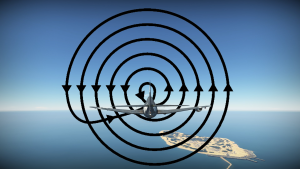Difference between revisions of "AN/APS-19"
(→General info / usage: Reformatted) |
(→General info / usage) |
||
| Line 24: | Line 24: | ||
! Band !! Pulse mode !! {{Annotation|PD|Pulse-Doppler}} mode !! {{Annotation|MTI|Moving target indication}} mode !! {{Annotation|IRST|Infrared search and track}} mode !! {{Annotation|TWS|Track-while-Scan}} mode !! {{Annotation|SARH|Able to guide semi-active radar-homing missiles}} | ! Band !! Pulse mode !! {{Annotation|PD|Pulse-Doppler}} mode !! {{Annotation|MTI|Moving target indication}} mode !! {{Annotation|IRST|Infrared search and track}} mode !! {{Annotation|TWS|Track-while-Scan}} mode !! {{Annotation|SARH|Able to guide semi-active radar-homing missiles}} | ||
|- | |- | ||
| − | | I || ✓ || X || X || X || X || | + | | I || ✓ || X || X || X || X || X |
|- | |- | ||
|} | |} | ||
Revision as of 15:03, 30 September 2023
Contents
Description
The AN/APS-19 is an American airborne target detection (search) radar with tracking capabilities. In game, it is found on the A2D-1.
Vehicles equipped with this radar
General info / usage
The AN/APS-19 is primarily a target detection radar however it does have a limited tracking capability. The radar has a theoretical maximum detection range of 60 km, however in reality air targets will always only be detected at much shorter distances (historically at long ranges the radar was mainly used to detect land masses).
Like the AN/APS-6, the AN/APS-19 historically operated in a "Spiral Scan" search pattern, however for simplicity it is modelled in game with an extremely rapid raster scan. In a spiral scan the radar dish spins rapidly, scanning the area in front of the aircraft following a spiral path (see image to the right). As a result of this, the radar appears to sweep very rapidly on the radar display, however targets are not updated on every pass as the radar is pointing at a different angle on each pass. Likewise, depending on where the radar is pointing,the effect of ground clutter is different, making it appear to "pulse" on the radar display.
The radar can lock on to and track targets within a narrow cone out to a maximum range of 1.5 km; however in order to do this the radar must cease scanning. This function mimics the gun aiming mode found on the real radar.
| Features | ||||||
|---|---|---|---|---|---|---|
| Band | Pulse mode | PD mode | MTI mode | IRST mode | TWS mode | SARH |
| I | ✓ | X | X | X | X | X |
| Search characteristics | ||||||
|---|---|---|---|---|---|---|
| Mode | Max range | Display ranges | IFF | |||
| SRC | 60 km | 4 km, 15 km, 37 km, 93 km |
✓ | |||
| Search modes | ||||||
|---|---|---|---|---|---|---|
| Mode | Scan type | Azimuth | Elevation | Period | ||
| SRC | One-way raster | ±15° | ±15° | 0.1 s | ||
| One-way raster | ±67.5° | ±62.5° | 1.52 s | |||
| Tracking characteristics | ||||||
|---|---|---|---|---|---|---|
| Mode | Max range | Azimuth limit | Elevation limit | |||
| TRK | 1.5 km | ±15° | ±15° | |||
Comparison with analogues
Much like the AN/APS-6, when compared to other wartime radars the AN/APS-19 has good scanning angles (slightly better than the AN/APS-6) and an OK range (same as the AN/APS-6). Compared to the AN/APG-26 the tracking angles of the AN/APS-19 are poor, although better than those on the RP-5. The tracking range is far inferior to both the AN/APG-26 and RP-5, but slightly better than the AN/APS-6.
Pros and cons
Pros:
- Decent range
- Can track targets
- Good horizontal scanning angles and very good vertical scanning angles
Cons:
- Inferior range and scanning angles to some high tier radars
- Tracking capability is limited
- Suffers very heavily from ground clutter
History
The AN/APS-19 was developed by the Sperry Corporation to be a lighter and more capable replacement for the AN/APS-4 and AN/APS-6 radars. The radar retained the spiral scan pattern and gun aiming modes of the AN/APS-6, but with a higher power output to increase range. The radar was also able to function in sweep-scan mode (where the radar sweeps side to side, like the AN/APS-21), retaining the functionality of the AN/APS-4 radar, but with better scanning angles. The radar was phased into service, starting in late 1946, gradually replacing AN/APS-4 and AN/APS-6 radars on naval aircraft.
Media
Excellent additions to the article would be video guides, screenshots from the game, and photos.
See also
- AN/APS-6 (a very similar radar)




